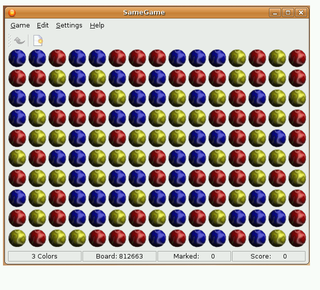
SameGame (さめがめ) is a tile-matching puzzle originally released under the name Chain Shot! in 1985 by Kuniaki Moribe (Morisuke). It has since been ported to numerous computer platforms, handheld devices, and even TiVo, with new versions as of 2016.

Lemmings is a puzzle–strategy video game originally developed by DMA Design in Dundee, Scotland and published by Psygnosis for the Amiga in 1991 and later ported for numerous other platforms. The game was programmed by Russell Kay, Mike Dailly and David Jones, and was inspired by a simple animation that Dailly created while experimenting with Deluxe Paint.

Xenophobe is a video game developed Bally Midway and released in arcades in 1987. Starbases, moons, ships, and space cities are infested with aliens, and the players have to kill the aliens before each is completely overrun. The screen is split into three horizontally-scrolling windows, one for each of up to three players, yet all players are in the same game world.

Chip's Challenge is a top-down tile-based puzzle video game originally published in 1989 by Epyx as a launch title for the Atari Lynx. It was later ported to several other systems and was included in the Windows 3.1 bundle Microsoft Entertainment Pack 4 (1992), and the Windows version of the Best of Microsoft Entertainment Pack (1995), where it found a much larger audience.
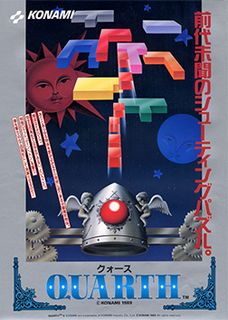
Quarth, known as Block Hole outside Japan, is a hybrid puzzle/shoot 'em up game developed by Konami which was released in 1989 as an arcade game. Besides the arcade version, there were also ports of the game to the MSX2, Famicom, and Game Boy—home releases used the Quarth name worldwide.
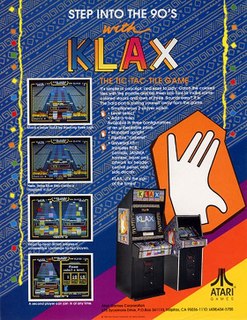
Klax is a puzzle video game released in arcades in 1990 by Atari Games while Namco distributed the game in Japanese markets. It was designed by Dave Akers and Mark Stephen Pierce. The object is to catch colored blocks tumbling down a machine and arrange them in colored rows and patterns to make them disappear. Klax was originally published as a coin-op follow-up to Tetris, about which Atari Games was in a legal dispute at the time.
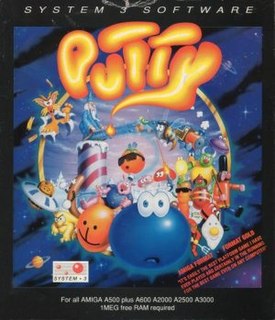
Putty is a game developed by System 3 and released in 1992 for the Amiga. It was also released on the Super Nintendo Entertainment System in 1993, under the name Super Putty in North America and Europe and as Putty Moon (パティームーン) in Japan. An Amiga CD32 version was published in 1994 as Super Putty.

Amidar is a video game developed by Konami and released in arcades in 1981 by Stern. The format is similar to that of Pac-Man: the player moves around a fixed rectilinear lattice, attempting to visit each location on the board while avoiding the enemies. When each spot has been visited, the player moves to the next level. The game and its name have their roots in the Japanese lot drawing game Amidakuji. The bonus level in Amidar is a nearly exact replication of an Amidakuji game and the way the enemies move conform to the Amidakuji rules; this is referred to in the attract mode as "Amidar movement."

Turrican II: The Final Fight is the second game of the Turrican series. The game, developed by Factor 5 was released in 1991 for the Commodore Amiga. This version was finished before the C64 version, but Manfred Trenz cites the C64 version as the original design. Turrican II was also released for the CDTV, Atari ST, Amstrad CPC and ZX Spectrum, and later for DOS, and also for the Mega Drive/Genesis and Game Boy rebranded as Universal Soldier.
XOR is a puzzle video game created by Astral Software and published by Logotron in 1987 for the Acorn Electron, Amiga, Amstrad CPC, Atari ST, BBC Micro, Commodore 64, and ZX Spectrum.

James Pond 3: Operation Starfish is a 1993 video game for the Mega Drive/Genesis. The game was also released for the Amiga and Amiga CD32 platforms, the Super NES and the Game Gear. It is the third and last game in the James Pond series. It is also the only one that was only released for AGA Amigas: the Amiga 1200, the Amiga 4000 and CD32.
Super Foul Egg is a Puyo Puyo clone for the Amiga and the Acorn Archimedes. It was inspired by Amiga Power's comment that no decent clone of the game was made for the machine. After reading the comment, a reader created the game and sent it to the magazine, which included it on their cover disk. The game went on to be ranked the 34th best game of all time by Amiga Power.

Brutal: Paws of Fury is a 2D fighting game published by GameTek in 1994. The game features a cast of various anthropomorphic animals as selectable fighters. It also features the ability to learn new attacks and save them via passwords. Originally a Sega CD exclusive, it was later ported to other game consoles.
DX-Ball is a freeware computer game for the PC first released in 1996 by Michael P. Welch and Seumas McNally. The game, originally based on an earlier series of Amiga games known as MegaBall, is patterned after classic ball-and-paddle arcade games such as Breakout and Arkanoid. A level editor was also made available as well. DX-Ball has been succeeded by three direct follow-ups: DX-Ball 2 (1998), Rival Ball (2001) and Super DX-Ball (2004).

The First Samurai, alternatively titled First Samurai, is a 1991 beat 'em up platformer developed by Vivid Image and published by Image Works. The First Samurai was originally released in September 1991 for the Amiga and Atari ST, and was later ported to the Commodore 64, MS-DOS and the Super Nintendo Entertainment System. It was followed by a sequel, Second Samurai.

Sword of Sodan is a hack and slash video game released for the Amiga in 1988 by Discovery Software, which also commissioned a port for the Apple IIGS. A scaled-down version for the Sega Genesis was released in 1990 by Electronic Arts, and in 1993 it was released for the Apple Macintosh System 7 by Bethesda Softworks.

Magic Boy is a platform game developed by Blue Turtle and published for the Amiga, Atari ST, and MS-DOS by Empire Interactive in 1993. A Super Nintendo Entertainment System version was published in 1996 in North America and Europe by JVC Musical Industries.
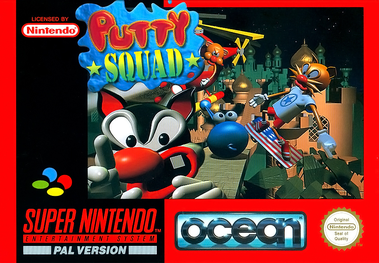
Putty Squad is a 1994 video game developed by System 3 and published by Maximum Games and Ocean Software. It was originally developed for the Amiga 1200, but that version was not released until the end of 2013; prior to that date the SNES version was the only one to be released. Sega Mega Drive and MS-DOS ports also existed, but were cancelled. It is the sequel to Putty (1992). In December 2013, the Amiga version was released as a Christmas gift on System 3's website. In October 2015, the Mega Drive version was also released by a Sega-16 user who got a hold of a working prototype.

Kirel is an isometric puzzle game written by Siegfried Kurtz for the ZX Spectrum and published by Addictive Games in 1986. "Kirel" must defuse the bombs before they explode while evading monsters which will sap his energy.

Thomas Was Alone is a puzzle-platform game created by Mike Bithell, originally released as a Flash-based browser game in October 2010. The game was expanded and released for Microsoft Windows and OS X in July 2012. It has subsequently been released for Linux, PlayStation 3, PlayStation 4, PlayStation Vita, Xbox One, Wii U, iOS, Android and Nintendo Switch platforms. In the game, the player controls one or more simple rectangles representing several out-of-control artificial intelligence entities, working with the shapes to get each to their individual end points on each level. Each shape is characterized by a unique name and personality, including the eponymous Thomas, which is conveyed to the player through the use of a narrator voiced by Danny Wallace, whose performance earned the game a BAFTA Games Award.

















